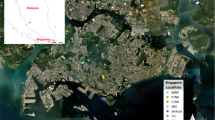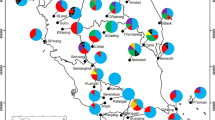Abstract
Due to changes in land use, remnants ofunfertilised, nutrient-poor calcareousgrassland in the Swiss Jura are small in areaand are highly fragmented. We selected 89 seedfamilies from eleven populations of varioussizes of Scabiosa columbaria for a studyof molecular diversity, and used the samematerial in a greenhouse experiment to measurevariation in fitness-related traits and theability of populations to cope withcompetition. Using RAPD-PCR we detected 71RAPD-phenotypes among 87 genotypes. Moleculardiversity within populations was variable andrelatively high, with an expectedheterozygosity H e ranging from 0.09 to0.24. H e, the Shannon index (SI) and thepercentage of polymorphic bands were notcorrelated with population size, but thesmallest populations had the lowest moleculardiversity (H e, SI). Populationdifferentiation was moderate with 12% of themolecular diversity among populations. Measuresof fitness in the greenhouse differed amongseed families (P < 0.001), but not amongpopulations. Mean above-ground biomass waslargely reduced when plants had to compete withBromus. Mean fitness of populationsdecreased when molecular diversity (H e)was low, but only when plants had to competewith Bromus (P = 0.02). Accordingly, therelative competition ability of Scabiosaplants decreased when molecular diversity(H e) was low (P = 0.01). Our resultssuggest an increased risk of local extinctionof Scabiosa columbaria in the Swiss Juracaused by a decreased viability and reducedphenotypic plasticity due to genetic erosion insmall populations.
Similar content being viewed by others
References
Arafeh RMH, Sapir Y, Shmida A, Iraki N, Fragman O, Comes HP (2002) Patterns of genetic and phenotypic variation in Iris haynei and I. atrofusca (Iris sect. Oncocyclus = the royal irises) along an ecogeographical gradient in Israel and theWest Bank. Mol. Ecol., 11, 39–53.
Behre K, Jacomet S (1991) The ecological interpretation of archaeobotanical data. In: Progress in Old World Palaeoethnobotany (eds. van Zeist W, Wasylikowa K, Behre K), pp. 81–108. Balkema, Rotterdam.
Bijlsma R, Oubourg N, Van Treuren R (1991) Genetic and phenotypic variation in relation to population size in two plant species: Salvia pratensis and Scabiosa columbaria. In: Species Conservation: A Population-Biological Approach (eds. Seitz A, Loeschcke V), pp. 89–101. Birkhäuser Verlag, Basel.
Bijlsma R, Ouborg N, Van Treuren R (1994) On genetic erosion and population extinction in plants: A case study in Scabiosa columbaria and Salvia pratensis. In: Conservation Genetics (eds. Loeschcke V, Tomink J, Jain S), pp. 255–271. Birkhäuser Verlag, Basel.
Buza L, Young A, Thrall P (2000) Genetic erosion, inbreeding and reduced fitness in fragmented populations of the endangered tetraploid pea Swainsona recta. Biol. Conserv., 93, 177–186.
Cain M, Milligan B, Strand A (2000) Long-distance seed dispersal in plant populations. Am. J. Bot., 87, 1217–1227.
Charlesworth D, Charlesworth B (1987) Inbreeding depression and its evolutionary consequences. Ann. Rev. Ecol. Syst., 18, 237–268.
Cheptou P, Berger A, Blanchard A, Collin C, Escarre J (2000) The effect of drought stress on inbreeding depression in four populations of the Mediterranean outbrossing plant Crepis sancta (Asteraceae). Heredity, 85, 294–302.
Ellstrand N, Elam D (1993) Population genetic consequences of small population-size-Implications for plant conservation. Annu. Rev. Ecol. Syst., 24, 217–242.
Fenster C, Dudash M (1994) Genetic considerations for plant population restoration and conservation. In: Restoration of Endangered Species: Conceptual Issues, Planning, and Implementation (eds. Bowles M, Whelan C), pp. 34–62. Cambridge University Press, Cambridge.
Fischer M, Matthies D (1998) RAPD variation in relation to population size and plant fitness in the rare Gentianella germanica (Gentianaceae). Am. J. Bot., 85, 811–819.
Fischer M, Stöcklin J (1997) Local extinctions of plants in remnants of extensively used calcareous grasslands 1950-1985. Conserv. Biol., 11, 727–737.
Fischer M, van Kleunen M, Schmid B (2000) Genetic Allee effects on performance, plasticity and developmental stability in a clonal plant. Ecol. Lett., 3, 530–539.
Frankham R (1996) Relationship of genetic variation to population size in wildlife. Conserv. Biol., 10, 1500–1508.
Gilpin M, Soulé M (1986) Minimum viable population: Processes of species extinction. In: Conservation Biology, the Science of Scarcity and Diversity (ed. Soulé ME), pp. 19–34. Sinauer, Sunderland, MA.
Grime J, Hodgson J, Hunt R (1988) Comparative Plant Ecology: A Functional Approach to Common British Species. Unwin Hyman, London.
Grünbauer G, Pfadenhauer J, Müller-Starck G (1999) Genetische Variation bei Wildpflanzen: Einfluss der Fragmentation auf Populationen von Succisa pratensis. Verh. Ges. Oek., 29, 425–436.
Heck KL, van Belle G, Simberloff, D (1975) Explicit calculation of the rarefaction diversity measurement and the determination of sufficient sample size. Ecology, 56, 1459–1461.
Hegi G (1918) Flora von Mitteleuropa. Lehmanns Verlag, München.
Huenneke L (1991) Ecolocigal implications of genetic variation in plant populations. In: Genetics and Conservation of Rare Plants (eds. Falk D, Holsinger K), pp. 31–44. Oxford University Press, New York.
Kery M, Matthies D, Spillmann H (2000) Reduced fecundity and offspring performance in small populations of the declining grassland plants Primula veris and Gentiana lutea. J. Ecol., 88, 17–30.
Knuth P (1898) Handbuch der Blütenbiologie. Wilhelm Engelmann, Leipzig.
Lacy R (1987) Loss of genetic diversity from managed populations: Interacting effects of drift, mutation, immigration, selection and population subdivision. Conserv. Biol., 1, 143–158.
Lammi A, Siikamaki P, Mustajarvi K (1999) Genetic diversity, population size, and fitness in central and peripheral populations of a rare plant Lychnis viscaria. Conserv. Biol., 13, 1069–1078.
Lande R (1988) Genetics and demography in biological conservation. Science, 241, 215–244.
Lauber K, Wagner G (1996) Flora Helvetica. Haupt, Bern.
Lesica P, Allendorf F (1995) When are peripheral-populations valuable for conservation. Conserv. Biol., 9, 753–760.
Lewontin RC (1972) The apportionment of human diverstiy. J. Evol. Biol., 6, 381–394.
Luijten H, Dierick A, Oostermeijer J, Raijmann L, Den Nijs H (2000) Population size, genetic variation, and reproductive stress in rapidly declining, self-incompatible perennial (Arnica montana) in The Netherlands. Conserv. Biol., 14, 1776–1787.
Mavraganis K, Eckert C (2001) Effects of population size and isolation on reproductive output in Aquilegia canadensis (Ranunculaceae). Oikos, 95, 300–310.
Miller M (1997) Tools for Population Genetic Analysis (TFPGA). A Windows Program for the Analysis of Allozyme and Molecular Population Genetic Data, 1. 3ed edn. Computer software distributed by the author.
Müller H (1873) Die Befruchtung der Blumen durch Insekten und die gegenseitige Anpassung beider. Wilhelm Engelmann, Leipzig.
Nei M (1973) Analysis of genetic diversity in subdivided populations. Proc. Natl. Acad. Sci. U.S.A., 70, 3321–3323.
Nybom N, Bartish I (2000) Effects of life history traits and sampling strategies on genetic diversity estimates obtained with RAPD markers in plants. Perspect. Pl. Ecol. Evo. Syst., 3, 93–114.
Oostermeijer J, Eijck M, Nijls J (1994) Offspring fitness in relation to population size and genetic variation in the rare perennial plant species Gentiana pneumonanthe (Gentianaceae). Oecologia, 97, 289–296.
Ouborg N, Van Treuren R (1995) Variation in fitness-related characters among small and large populations of Salvia pratensis. J. Ecol., 83, 369–380.
Ouborg N, Van Treuren R, Van Damme J (1991) The significance of genetic erosion in the process of extinction: II. Morphological variation and fitness components in populations of varying size of Salvia pratensis L. and Scabiosa columbaria L. Oecologia, 86, 359–367.
Papa R, Attene G, Barcaccia G, Ohgata A, Konishi T (1998) Genetic diversity in landrace populations of Hordeum vulgare L. from Sardinia, Italy, as revealed by RAPDs, isozymes and morphophenological traits. Plant Breed., 117, 523–530.
Podolsky R (2001) Genetic variation for morphological and allozyme variation in relation to population size in Clarkia dudleyana, an endemic annual. Conserv. Biol., 15, 412–423.
Pott R (1995) The origin of grassland plant species and grassland communities in Central Europe. Fitosociologia, 29, 7–32.
Reed DH, Briscoe DA, Frankham R (2002) Inbreeding and extinction: The effect of environmental stress and lineage. Conserv. Gen., 3, 301–307.
Reed D, Frankham R (2001) How closely correlated are molecular and quantitative measures of genetic variation? A meta-analysis. Evolution, 55, 1095–1103.
Reynolds HL (1999) Plant interactions: Competition. In: Handbook of Functional Plant Ecology (eds. Pugnaire FI, Valladares F), pp. 649–676. Marcel Dekker AG, New York.
Ryf M (1997) Veränderung in der Artzusammensetzung von Kalkmagerrasen im Nordwestschweizer Jura in den letzten 40 Jahren. Diploma-thesis, University of Basel, Switzerland.
Schlichting C (1986) The evolution of phenotypic plasticity in plants. Annu. Rev. Ecol. Syst., 17, 667–693.
Schmidt K, Jensen K (2000) Genetic structure and AFLP variation of remnant populations in the rare plant Pedicularis palustris (Scrophulariaceae) and its relation to population size and reproductive components. Am. J. Bot., 87, 678–689.
Schneider S, Kueffer J-M, Roessli D, Excoffier L (1997) Arlequin: A Software for Populations Genetic Data Analysis, 1.1st edn. Genetics and Biometry Laboratory, University of Geneva, Switzerland.
Snaydon RW (1991) Replacement or additive designs for competition studies. J. Appl. Ecol., 28, 930–946.
Sokal R, Rohlf F (1995) Biometry. Freeman WH and Company, New York.
Srikwan S, Woodruff D (2000) Genetic erosion in isolated small mammal populations following rainforest fragmentation. In: Genetics, Demography and Viability of Fragmented Populations (eds. Young A, Clarke G), pp. 149–172. Cambridge University Press, Cambridge.
Stöcklin J, Fischer M (1999) Plants with longer-lived seeds have lower local extinction rates in grassland remnants 1950-1985. Oecologia, 120, 539–543.
Stöcklin J, Ryf M, Fischer M (2000) Small size of remnants of nutrient-poor calcareous grassland (Mesobromion) in the Swiss Jura puts many plant species at risk of local extinction. Z. Oek. Naturschutz, 9, 109–118.
Sultan SE (2000) Phenotypic plasticity for plant development, function and life history. Trends Plant Sci., 5, 537–542.
Van Treuren R, Bijlsma R, Ouborg N, Kwak M (1994) Relationships between plant density, outcrossing rates and seed set in natural and experimental populations of Scabiosa columbaria. J. Evol. Biol., 7, 287–302.
Van Treuren R, Bijlsma R, Ouborg N, Van Delden W (1993) The significance of genetic erosion in the process of extinction: IV. Inbreeding depression and heterosis effects caused by selfing and outcrossing in Scabiosa columbaria. Evolution, 47, 1669–1680.
Van Treuren R, Bijlsma R, Van Delden W, Ouborg N (1991) The significance of genetic erosion in the process of extinction: I. Genetic differentiation in Salvia pratensis and Scabiosa columbaria in relation to population size. Heredity, 66, 181–190.
Vazquez J, Gomez-Mercado F, Guerrero J, Rodriguez-Garcia I, Garcia-Maroto F (1999) Genetic relationships and population structure within taxa of the endemic Sideritis pusilla (Lamiaceae) assessed using RAPDs. Bot. J. Linnean Soc., 129, 345–358.
Vergeer P, Rengelink R, Copal A, Ouborg N (2003) The interacting effects of genetic variation, habitat quality and population size on performance of Succisa pratensis. J. Ecol., 91, 18–26.
Waldmann P, Andersson S (1998) Comparison of quantitative genetic variation and allozyme diversity within and between populations of Scabiosa canescens and S. columbaria. Heredity, 81, 79–86.
Wright S (1977) Evolution and the Genetics of Populations, Vol. 3. Experimental Results and Evolutionary Deductions. University of Chicago Press, Chicago.
Yeh F, Yang R, Boyle T, Ye Z-H, Mao J (1997) POPGENE, the User-Friendly Shareware for Populations Genetics Analysis, 1. 21nd edn. Molecular Biology and Biotechnology Centre, University of Alberta, Edomnton.
Young A, Boyle T, Brown T (1996) The population genetic consequences of habitat fragmentation for plants. Trends Ecol. Evol., 11, 413–418.
Zoller H (1954) Die Typen der Bromus erectus-Wiesen des Schweizer Jura. Verlag Hans Huber, Bern.
Zoller H, Wagner C, Frey V (1986) Nutzungsbedingte Veränderungen in Mesobromion-Halbtrockenrasen in der Region Basel-Vergleich 1950-1980. Abh. Wesfäl. Museum f. Naturk., 48, 93–108.
Author information
Authors and Affiliations
Corresponding author
Rights and permissions
About this article
Cite this article
Pluess, A.R., Stöcklin, J. Genetic diversity and fitness in Scabiosa columbaria in the Swiss Jura in relation to population size. Conservation Genetics 5, 145–156 (2004). https://doi.org/10.1023/B:COGE.0000029999.10808.c2
Issue Date:
DOI: https://doi.org/10.1023/B:COGE.0000029999.10808.c2




